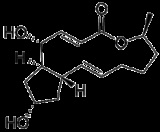
Brefeldin A
Encyclopedia
Brefeldin A is a lactone
antibiotic
produced by fungal organisms such as Eupenicillium brefeldianum. Brefeldin A inhibits transport of proteins from ER to Golgi and induces retrograde protein transport from the Golgi apparatus
to the endoplasmic reticulum
. This leads to proteins accumulating inside the ER. In mammalian and yeast
cells, the main target of brefeldin A appears to be a certain type of GTP
-exchange factors responsible for activating a GTPase
called Arf1p ; in turn, Arf1p is involved in the formation of transport vesicles
by recruiting coat proteins to intracellular membranes. Brefeldin A was initially isolated as an anti-viral
antibiotic but is now primarily used in biological
research to study protein transport.
Brefeldin A affects COPI coat formation, which is involved in retrograde transport. It inhibits ArfI activation, prohibiting recruitment of COPI coat proteins to the budding vesicle by binding to its guanine exchange factor.
Lactone
In chemistry, a lactone is a cyclic ester which can be seen as the condensation product of an alcohol group -OH and a carboxylic acid group -COOH in the same molecule...
antibiotic
Antibiotic
An antibacterial is a compound or substance that kills or slows down the growth of bacteria.The term is often used synonymously with the term antibiotic; today, however, with increased knowledge of the causative agents of various infectious diseases, antibiotic has come to denote a broader range of...
produced by fungal organisms such as Eupenicillium brefeldianum. Brefeldin A inhibits transport of proteins from ER to Golgi and induces retrograde protein transport from the Golgi apparatus
Golgi apparatus
The Golgi apparatus is an organelle found in most eukaryotic cells. It was identified in 1898 by the Italian physician Camillo Golgi, after whom the Golgi apparatus is named....
to the endoplasmic reticulum
Endoplasmic reticulum
The endoplasmic reticulum is an organelle of cells in eukaryotic organisms that forms an interconnected network of tubules, vesicles, and cisternae...
. This leads to proteins accumulating inside the ER. In mammalian and yeast
Yeast
Yeasts are eukaryotic micro-organisms classified in the kingdom Fungi, with 1,500 species currently described estimated to be only 1% of all fungal species. Most reproduce asexually by mitosis, and many do so by an asymmetric division process called budding...
cells, the main target of brefeldin A appears to be a certain type of GTP
Guanosine triphosphate
Guanosine-5'-triphosphate is a purine nucleoside triphosphate. It can act as a substrate for the synthesis of RNA during the transcription process...
-exchange factors responsible for activating a GTPase
GTPase
GTPases are a large family of hydrolase enzymes that can bind and hydrolyze guanosine triphosphate . The GTP binding and hydrolysis takes place in the highly conserved G domain common to all GTPases.-Functions:...
called Arf1p ; in turn, Arf1p is involved in the formation of transport vesicles
Vesicle (biology)
A vesicle is a bubble of liquid within another liquid, a supramolecular assembly made up of many different molecules. More technically, a vesicle is a small membrane-enclosed sack that can store or transport substances. Vesicles can form naturally because of the properties of lipid membranes , or...
by recruiting coat proteins to intracellular membranes. Brefeldin A was initially isolated as an anti-viral
Virus
A virus is a small infectious agent that can replicate only inside the living cells of organisms. Viruses infect all types of organisms, from animals and plants to bacteria and archaea...
antibiotic but is now primarily used in biological
Cell biology
Cell biology is a scientific discipline that studies cells – their physiological properties, their structure, the organelles they contain, interactions with their environment, their life cycle, division and death. This is done both on a microscopic and molecular level...
research to study protein transport.
Physical data
- Solubility: Clear colorless solution at 10 mg/ml Dichloromethane.
- Clear colorless solution at 10 mg/ml Methanol.
Brefeldin A affects COPI coat formation, which is involved in retrograde transport. It inhibits ArfI activation, prohibiting recruitment of COPI coat proteins to the budding vesicle by binding to its guanine exchange factor.

